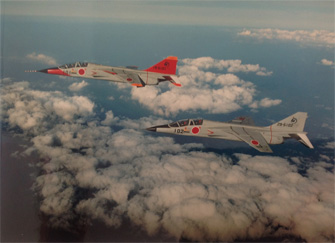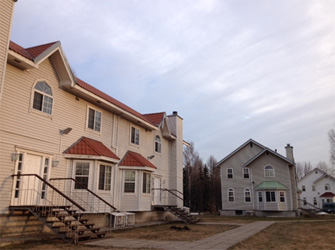Hello everyone.
This month, I am finally going to get to the end of the story of how I became a test pilot. If it is well-received, I could maybe continue on with the story up until I became an astronaut candidate.
So, I came back to Japan and finished the fighter jet operations course in a T-2 practice plane without incident and went on to work towards being an F-15 pilot. My next test was...
That’s right! G-force resistance training. Usually on a fighter jet you have to wear a g-suit which is a kind of pair of trousers (?) that increase pressure on the lower body with air pressure (it is said that if you wear these, your g-force resistance improves by about 2 gs). However, during g-force resistance training, you are not allowed to wear a g-suit.
This was the g-force resistance training which I had failed at so many times in the past.... This time, I had to resist 8 gs without a g-suit.... To be completely honest, I was very anxious about it and when I got into the capsule, I had an indescribable felling of tension. When the acceleration started, I could hear the operator’s voice as usual.
Operator: 2g...3g...
Me: Grayout! Hook! Hook...
And up until that point, everything was as usual...
Operator: 3g...4g...5g...
Me: Hook... (Wow, this is hard...but I’m still OK!)
Operator: 6g...7g...
Me: Hook... (It’s still hard...and I’m getting a bit tired...)
Operator: Keep going! 8g...
Me: Hook. (Yes! But if I lose focus now, I’ll faint! I have to keep up my endurance!)
Operator: OK! Deceleration! 7g...6g...5g...4g...Stop!
Me: Yes! I finally managed it!
At the briefing afterwards, I received the comment, ‘The fact that you had a grayout so soon may mean that your actual g-force resistance is low but you managed to tough it out with stamina! Well done!’ At last, I had conquered the g-forces that were such a huge obstacle to me even though they are not such an obstacle to anyone else. (I digress but, the experience of not being able to resists g-forces and having fainted three times was really useful to me in fighter jet operations. Because I knew so much about the stages before you pass out, I could go right to the limit before passing out but never went past that line again.)
So, after the g-force training, I started F-15 flight training. When I was learning about the F-15 model conversion and the basics of combat as a unit, my experience studying overseas really came in handy!
The theory of fighter combat has changed along with advancements in fighter jets but the theory that we had learned in the US was comparatively new in Japan as well and at the time it was called New BFM(Basic Fighter Maneuvers). I had been able to learn the basics of this in the US so it was relatively easy to incorporate into the basics of combat in an F-15. And, my own personal study of psychology was also extremely useful. It may not be for me to say but by learning a good balance of combat theory and psychology, I think I became a pilot with a well-balanced way of thinking.
For example, the performance of aeroplanes or missiles just follows the laws of physics so even if you put your heart into it, you can’t turn any faster or extend the range any further. On the other hand, when the performance of planes improves, it is possible that you may be under the influence of the g-forces that I was so bad at for a long period of time so, from that aspect, if you don’t put your all into it, you cannot get a 100% performance out of the plane. At the time, and even now, in a comparison of the number and performance of the fighter jets in Japan and its neighbouring countries, Japan is in an inferior position so if a pilot did not have the skill to get a 100% performance from the plane, there would be no chance of winning. The training for the fighter jet corps of the Self-Defense Force was really hard going on an everyday basis but I managed to get through it all and became a fighter jet pilot in my own right.
Around that time was an important period for me in which I would choose the next step in my career path. I really wanted to stay in the fighter jet corps but there were so many other different things that I wanted to experience so, to be honest, I agonized over this. Should I stay in the fighter jet corps for a few more years, get the flight experience (hours) that I needed to become a test pilot and then take the test pilot course or should I choose another path? This was when I expressed my wishes to become a training instructor at the National Defense Academy and to go back to my alma mater. This was due to the fact that I had an interest in education as well as the fact that I recognised the importance of education.
The work as a National Defense Academy instructor was one of the most interesting jobs that I had during my time in the Self-Defense Force. On the one hand, I felt awe at the fact that, as an instructor, I could have an influence on the way young people think... and as a result, I started to wonder if I was a suitable person to be an instructor...but if I start writing about this, I won’t get to the end of the story about how I got to be a test pilot so I will leave that for another time.
So, there was a problem with me becoming an instructor at the National Defense Academy. Me, who wanted to be a test pilot. This was because I did not have enough flight experience to become a test pilot. Obviously, when you are an instructor, your number of annual flight hours decreases dramatically. And, unfortunately, it also becomes difficult to improve your flying skills. To be frank, I was not 100% confident that I would become a test pilot. However, a lot of different people gave me advice and I put in for the test pilot course which is one of the most difficult training courses in the Self-Defense Force. I was assigned to the Gifu base. There were 5 people on the course: 3 fighter jet pilots and 2 transporter plane pilots. As I mentioned before, I was the one with the least flight experience. However, frankly, I had continuous problems as the head of the students who was supposed to consolidate the group. Without time to even get my dulled flight intuition back, I began some difficult training and I was up to my eyes just with dealing with myself but as the student leader, I also had to consolidate the group. In this situation, I keenly felt the importance of the team. When I was having a hard time, my colleagues on the test pilot training course always helped me and my family gave me all kinds of support so that I could concentrate on the training. Our instructors were strict but genial and watched over us attentively. It was only with the assistance of many people that I was able to graduate from the difficult test pilot course!
If you are thinking that I got through my training without problem, became a test pilot and was able to go straight into doing test flights then you are mistaken ? life is not a box of chocolates! The Self-Defense Force has a Staff College which has a one year course where you can learn the skills to command a unit or assist a commander. This course is called the Command and Staff Course. Would you believe that I was given the chance to take this course directly after I had graduated from the test pilot course? The problem was that if I took the Command and Staff Course without gaining any experience of the actual work of a test pilot, it would be really difficult to return to Gifu as a test pilot... Yet another thing that I had to agonize over but, in the end, I decided to go on and take the Command and Staff Course. I didn’t want to waste an opportunity to have a new experience.
It is no exaggeration to say that the year I spent on the Command and Staff Course was the year in which I learned the most in my life. I will tell you more about that another time!
Anyway, I managed to overcome the long-standing jinx in the Self-Defense Force that it was not possible to go back to Gifu as a test pilot if you went straight on to the Commander and Staff Course directly after the test pilot course and my passionate wish to return was granted! I was 34 at the time. At last, I had got the chance to work as a test pilot! And this was the start of my ‘Right Stuff’ story from being a ‘Space Turtle (my nickname) ’ test pilot to being an astronaut.
However, on the other hand, when I was selected as an astronaut candidate, someone at JAXA told me that it was rare to find someone with the same amount of different experiences as me. If I had been evaluated for the knowledge and abilities that I had gained from my diverse experience, my ‘Right Stuff’ story probably started when I was 17 and I decided to join the Self-Defense Force. A lot of different things happened to me such as things not working out the way I had originally hoped or the appearance of life choices that I would never have imagined but I think it must have been the fact that I continued to strive never to forget the goals of my life and to be positive that led, in the end, to me obtaining support from other people and producing good results.
Anyway, I have given you a rough outline of how I became a test pilot over three months of my journal. What did you think? To be honest, due to space and time restrictions, there were a lot of things that I couldn’t tell you about. If possible, I would like to write further about these when I get the chance. If you have any requests for things you would like me to write about, please do not hesitate to let me know! I hope we can work together on creating a really great journal!

This is a photo of a Gifu Base T-2 plane. It is no longer used as it has been retired from service. The plane marked 101 was a test plane and was used for diverse tests so it was highly coloured in this way to improve visibility. The Pitot tube (measures the stress of airspeed using the difference between dynamic and static pressure of air flow) that is attached to the nose of the plane is also a standard pitot tube for testing. Every first prototype plane has this Pitot tube attached.
*Photo: JAXA






